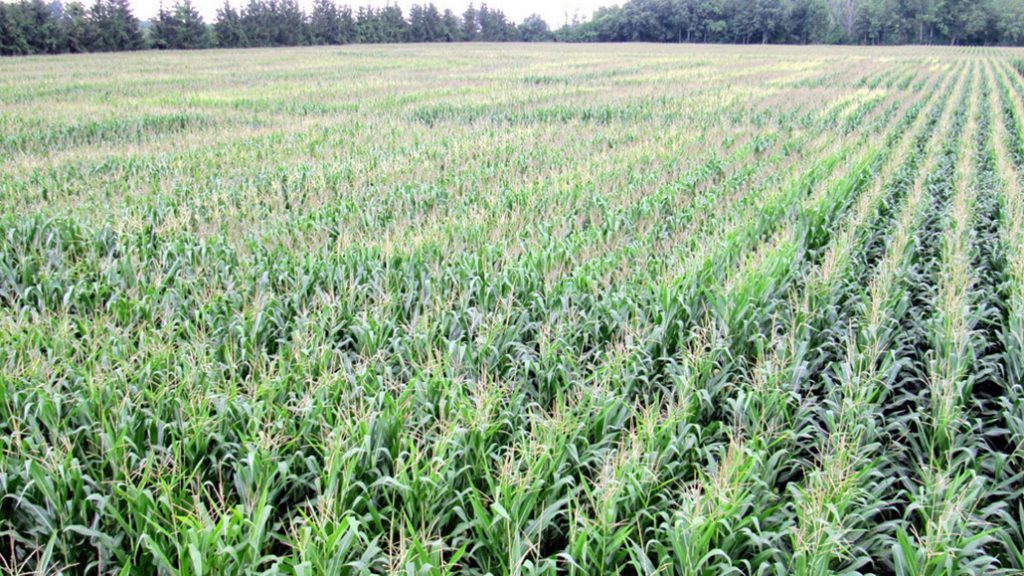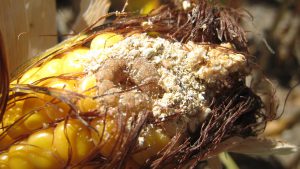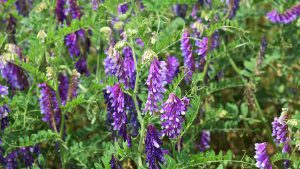A lasting impact
TWO UNIVERSITY OF GUELPH RESEARCHERS RETIRE

WITH NEARLY SIX decades of combined experience in crop science research at the University of Guelph, two prominent faculty members have recently announced their retirements.
Dr. Bill Deen and Dr. Art Schaafsma formally retired from their respective roles as associate professor and professor in the department of Plant Agriculture last October. Both of them have been recognized provincially, nationally, and internationally for their numerous teaching and research contributions.

DR. BILL DEEN
When Dr. Bill Deen was asked to apply for the cropping systems position at the University of Guelph’s main campus in 2000, it caught him by surprise. He had just completed his PhD in weed science and crop physiology and was working at the Ridgetown Campus but didn’t feel he was qualified for the job.
He thought his background was too diverse — he had worked in the crop protection industry, obtained a master’s degree in economics, and worked in policy at the George Morris Centre. But in hindsight, Deen thinks his varied experience is likely what spurred his colleagues’ ask.
“When you’re working in systems, diversity matters,” he says.
Deen was ultimately successful in the hiring competition and maintained the associate professor role until retirement. Over the course of 20 years, he says he often referred to his economics and policy background and contacts in the business sector.
Deen’s role included teaching undergraduate and graduate courses, leading research, and conducting extension activities.
As a faculty member, he had the longest association with the cropping systems course for fourth year undergraduate students. It is the only course he taught consecutively for 20 years and the one he enjoyed most, partially because of how many past students he now sees directly involved in Ontario agriculture.
University alumni aside, Deen is best known for his accomplishments as a researcher. The overall objective of his research was to develop agroecosystems that are both productive and sustainable. He focused on the mechanisms underlying carbon cycling, nutrient cycling, and yield as influenced by crop species, tillage, cover crops, and crop rotation.
RESEARCH ADVANCEMENTS
“When I first arrived at the University, there was a lot of discussion about soil carbon sequestration and water quality. It was surprising how much of that discussion revolved around no-till systems,” says Deen. “Now we’re recognizing that when we’re talking about soil health, soil carbon, and water quality, it’s not just a tillage issue — it’s a systems issue. I’d like to think some of the early work we did on tillage systems played a role in informing that discussion.”
The evolution of cover crops tells a similar story. In Deen’s early years as a researcher, there was interest in cover crops but not a lot of adoption aside from some farmers using red clover.
“It seemed like we were doing all of this work and not impacting adoption,” he recalls. “In recent years, red clover usage is down but there’s a lot of interest and increasing uptake in the adoption of cover crops in our systems.”
Deen says rotation diversity is likely the research area where he had the most productivity over the years. He conducted research in collaboration with associate professor Dr. Dave Hooker and suggests their findings are connected to maintaining wheat acreage in Ontario.
“Twenty years ago, wheat was a third crop that was almost begrudgingly grown. It was the poor cousin of corn and soybeans,” he explains. “The role of wheat and the recognition of its economic contribution has changed. Now growers are much more keen to figure out how to make wheat in rotation work. They are more keen about the concept of cover crops after wheat as part of a good system and they’re much more aware that if you have a good rotation, you can intensify tillage.”
Assistant professor Dr. Joshua Nasielski says Deen’s research contributions are very important to the industry. “You can go to a place like C&M Seeds, open up any ad and see Bill quoted directly. That’s the impact of his work on rotation diversity.”
Deen was Nasielski’s advisor in graduate school and then his colleague in the department. They studied Nitrogen (N) management in corn, another area of research where Deen stands out.
“One thing that is unique about Bill is that he is a farmer himself,” says Nasielski. “N management in corn is a topic studied by many people, but Bill’s research is unique because he really cares about the practicality of research implications. He always had a good perspective on how farmers are actually making decisions and that was really valuable as a student.”
“Over the years, I’ve heard so many people say we have to optimize the N rate,” says Deen. “They suggest that there is this precise rate where we optimize economics in a system, but the data just doesn’t support that. This finding has profound implications for how we approach N management.”
CAREER HIGHLIGHTS
Deen’s practical farm roots are likely at play when he calls the long-term field trials at the Elora Crop Research Station the highlight of his career. He says the tillage, rotation, N in corn, and C4 grass for biomass trials led to a great deal of output, interaction with other scientists, and many research publications. His long-term trial findings have also played a role in impacting farmer behaviour and policy discussions.
Former professor Dr. Terry Daynard started two of the four trials that Deen managed for the last 20 years.
“Bill assumed responsibility for some valuable long-term research and advanced the science substantially during his career,” says Daynard. “He trained many good graduate students and was known for his objectivity and integrity in stating what his research data really said. When Bill told others what the research shows, you could count on him being right.”
Hooker shares Daynard’s sentiments that Deen’s leadership in managing the long-term trials is among his most notable achievements.
“Bill’s leadership is selfless and has built multi-disciplinary collaborative teams with dozens of researchers, as evidenced by dozens of invited presentations per year, and over 150 peer-reviewed papers with over 2,300 citations,” says Hooker.
To Grain Farmers of Ontario’s manager of research and innovation, Dr. Josh Cowan, Deen excelled in balancing the practical needs of farmers with the pursuit of scientific excellence.
“His recent work to engage farmers, agronomists, and research colleagues in the ongoing development of an improved N decision support tool has kickstarted a unique research path that is already showing its value,” he says.
LOOKING AHEAD
Going forward, Deen hopes systems level research continues to be encouraged and supported.
“It’s important that we continue to evaluate this concept of system complexity and try to better understand what level of system complexity we should be aiming for,” he says.
He also stresses that recent N management research, including using the delta yield approach to generate farm data, should be continued because it has the potential to be transformative.
While Deen will still be involved in some N management research in 2021, he is looking forward to dedicating more time to his broiler and crop farm now that he is retired. He knows he wants to give back to the industry in some way and plans to explore service options in the future. While he has yet to map out what a retirement role could entail, there’s no doubt Ontario agriculture will benefit from any knowledge and expertise he shares.
| WHAT YOU NEED TO KNOW • Deen was hired as an associate professor in 2000. His focus was on cropping systems. • Deen says rotation diversity is likely the research area where he had the most productivity over the years. • Deen calls the long-term field trials at the Elora Crop Research Station the highlight of his career. • Nitrogen (N) management in corn is another area of research where Deen stands out. |

DR. ART SCHAAFSMA
Passionate, practical, and the go-to resource for field crop pest management are a few of the ways Dr. Art Schaafsma is described by his colleagues in Ontario agriculture. A past director of the University of Guelph Ridgetown Campus and a professor in the department of Plant Agriculture for more than 30 years, Schaafsma was celebrated as a valued faculty member upon his retirement.
He studied at the University of Guelph as a student and worked for two agricultural companies before joining his alma mater as a researcher and instructor in 1987. Between completing his PhD in 1990 and retiring last fall, his job description did not see many changes but his research focus continually shifted to adapt to new pest challenges.
“My main area of research was insect and disease management in field crops,” he says. “My work was quite varied over the years, but Fusarium is one of the main topics I’ve been involved with since the beginning.”
FOCUS ON FUSARIUM
Although never problematic in the same year during his tenure, Schaafsma spent significant time researching Fusarium head blight (FHB) in wheat and Gibberella ear rot in corn. He has seen Fusarium cause major problems for farmers and tells the story of how Mother Nature played a role in making FHB a research priority in 1996.
He was driving to a meeting in Illinois when he received a phone call that advised him a small tornado had hit Ridgetown Campus. Although his research plots were scattered across the campus, the tornado seemed to follow the same path and all of his research was destroyed.
“I was actually thankful for the tornado because as I was driving, I could see all of the wheat fields turning white really prematurely,” he says. “I knew it was going to be a horrible crop, so I quickly called the companies who sponsored the destroyed plots. I asked them if they would reinvest in Fusarium research so we could learn as much about the current epidemic as possible. That’s how it started.”
The change in course led Schaafsma and his team to visit 100 Ontario farms to sample wheat before and during harvest. They asked farmers for specific information about the management of each sampled field. “A fungicide emerged from that research and we got an emergency registration for the following spring. We learned a lot about the agronomy from the data set we collected and developed a model to predict Fusarium,” he says.
“Art’s work on wheat variety disease screening, FHB model development, fungicide timing, and sprayer application, for example, have led to effective Fusarium management programs and helped to prevent another 1996,” says Albert Tenuta, field crop plant pathologist with the Ontario Ministry of Agriculture, Food and Rural Affairs (OMAFRA), who worked with Schaafsma for more than 25 years on various applied research and extension related projects.
“Art has worked tirelessly to reduce the economic impact of Fusarium and mycotoxins in wheat and corn for the growers of Ontario and we are all indebted to him for his passion, dedication, and contributions,” adds Tenuta.
Schaafsma’s studies have also led to some management tools for Fusarium in corn but he says there have not been nearly as many gains in this area.
Despite Schaafsma’s frustration with Fusarium in corn research, Dr. Josh Cowan, manager of research and innovation at Grain Farmers of Ontario, says he is still the go-to resource for DON management.
“Whether it was helping farmers come out stronger on the other side of the DON epidemic in wheat in the 1990s or his most recent efforts to improve comprehensive DON management and sampling options in grain corn in response to DON epidemics in recent years, Art and his research team could be counted on to work with the sector to find practical solutions for farmers,” he says.
PEST PROGRESS
Invasive pests were also a focus for Schaafsma during his career. Learning about and developing solid management tools for spider mites and soybean aphids are among his highlights.
“The progress with the soybean aphid is really satisfying. Everyone was spraying like crazy when it first invaded and now we hardly spray at all. That is a very major development that is really exciting to see,” says Schaafsma, who collaborated with professor Dr. Rebecca Hallett and numerous graduate students on this topic.
More recently, Schaafsma and his team studied western bean cutworm (WBC). “We learned that the insect became resistant to Bt corn. We’ve come some distance, but WBC is still a challenge so we’re working behind the scenes with industry partners on new proteins for resistance,” he says.
Tracey Baute, field crop entomologist with the OMAFRA, was Schaafsma’s first graduate student in the late 1990s. She says he has mentored her for the majority of her career.
“Art always thinks of growers first and is very dedicated to finding practical scouting and management options for them,” explains Baute. “His work on Bt corn and leadership as chair of the Canadian Corn Pest Coalition stand out. He worked hard to encourage collaboration between industry, government, academia, and regulatory representatives to develop and follow best management practices to maintain the effectiveness of Bt corn against target pests. That collaboration was often desired by our counterparts in the United States but could not be achieved there in the same way. I know Art felt personally responsible for trying to make that collaboration happen.”
TEACHING SUCCESS
Dr. Jocelyn Smith, research scientist at the University of Guelph, began working with Schaafsma as a master’s student. She then joined his team as a research technician and has now completed her PhD. She says she appreciates the opportunities Schaafsma gave her to manage entomology research projects and develop as a scientist over the last 10 years.
“An aspect of Art’s legacy that people may not be as aware of is the large number of diploma, undergraduate, and graduate students that he has trained and the impact he had on their careers,” says Smith.
Many of his former students now work in provincial or federal government positions, at other universities in teaching or research positions, and in other industry roles.
Schaafsma says he has had “the most fun” while working with graduate students over the years. “They contribute a lot and I learn a lot from them too. You get involved in their lives and it is a real joy.”
FUTURE OUTLOOK
Although formally retired, he will continue to support a handful of graduate students for the next few years until their studies are complete.
In the future, Schaafsma would like to see continued research of Fusarium in corn. “2018 was a disaster and it could happen again because we still don’t have the right tools, mainly hybrids that are more tolerant,” he says.
He notes there is also work to be done to finish solving the puzzle of WBC. Schaafsma sees Smith as a key contributor to future entomology research.
“I am continuing the research that Art and I were working on together and pursuing many new projects as well. I hope to keep the field crop entomology research program at Ridgetown going strong,” says Smith. •
| WHAT YOU NEED TO KNOW • Dr. Art Schaafsma was a professor in the department of Plant Agriculture for more than 30 years. • Schaafsma’s main area of research was insect and disease management in field crops. He spent significant time researching Fusarium head blight (FHB) in wheat and Gibberella ear rot in corn. • Recently, Schaafsma and his team studied western bean cutworm (WBC). • Schaafsma has trained a significant number of people who now work in government, industry, and academia. |




















